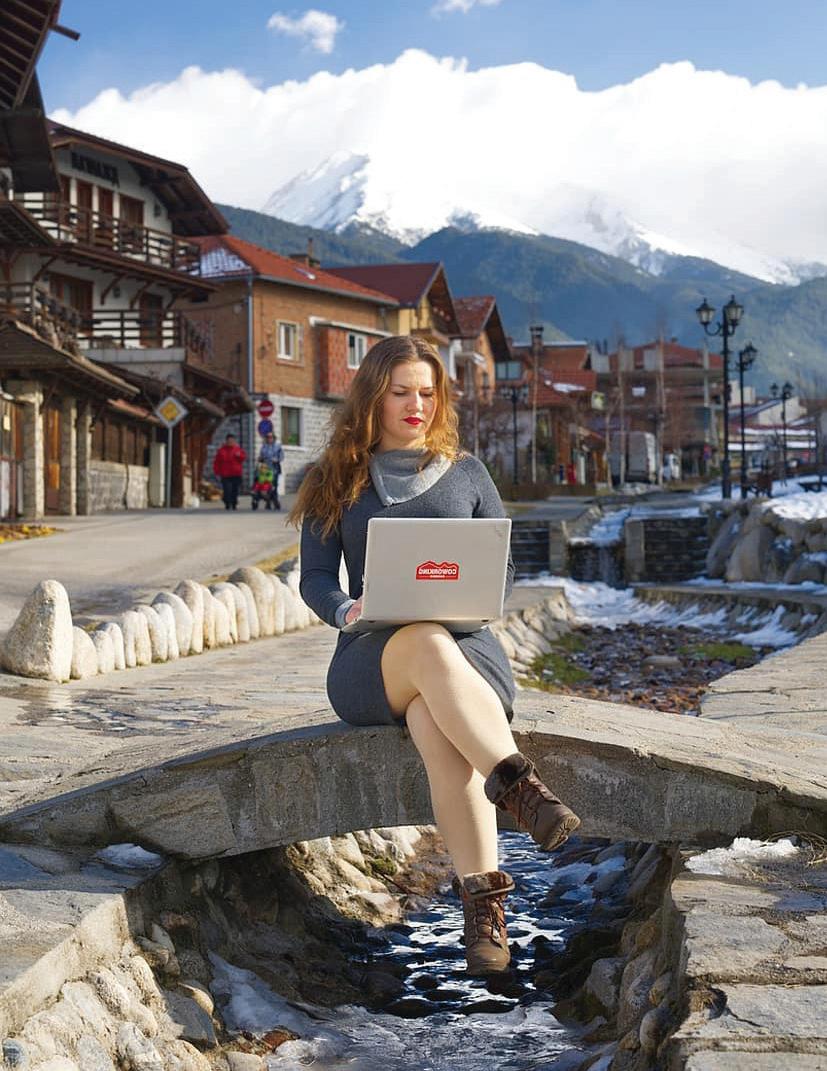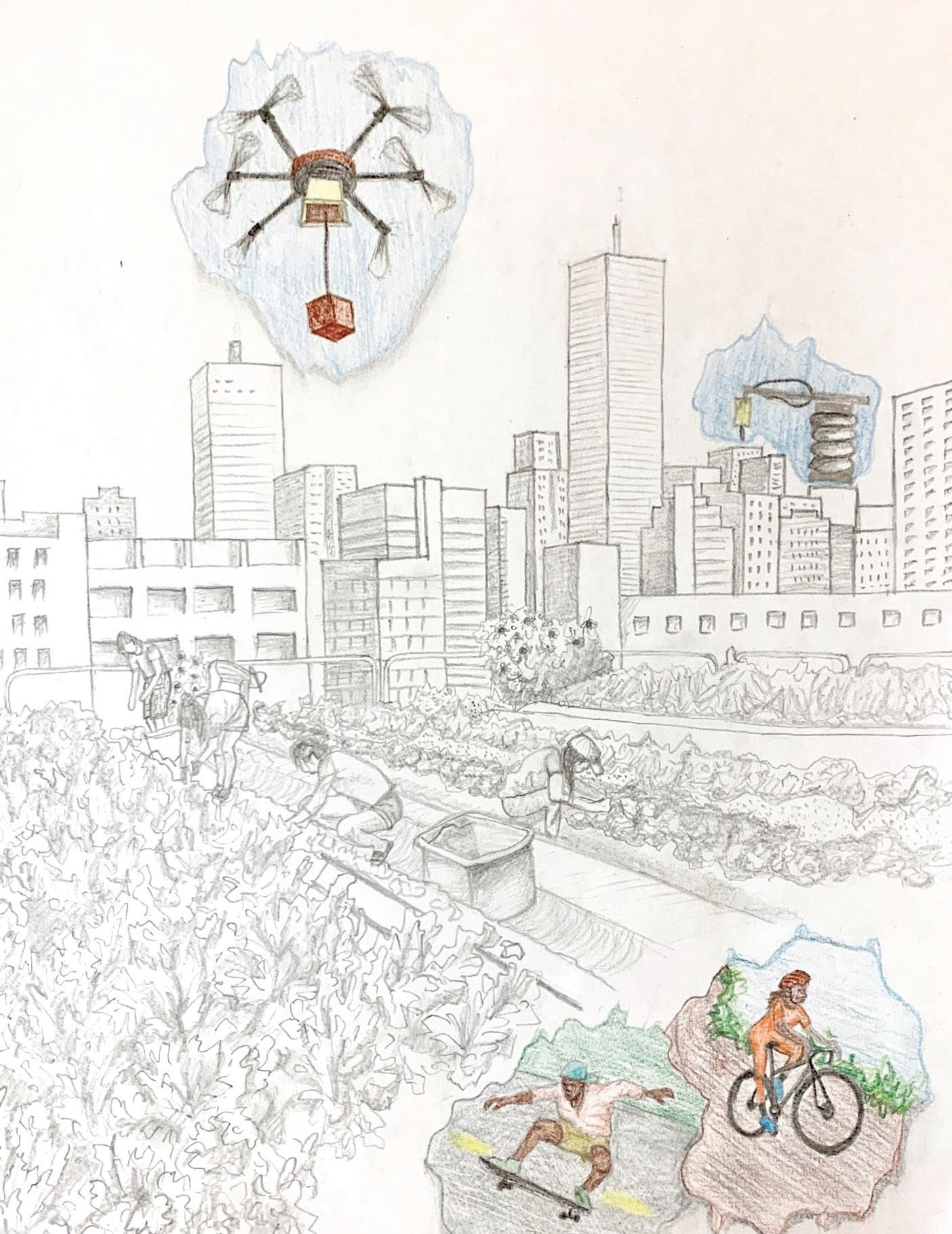
6 minute read
SCENARIO 2 | NOMADIC FABRIC
Since remote work proved effective, the recognition that the link between time and space is dynamic and can change became more apparent than ever before. Employees are not only loosely coupled to one organization; they typically work for multiple organizations at the same time. They are hired based on very specific skills and competencies needed to maintain business operations and functions, turnaround or ideate new services and products. Nomadic employees prioritize being on the move over the location of company headquarters. At the same time, it is possible to continue to work in one country but live in an entirely different country. It is not unusual for someone to have lived in 10 different countries at a minimum over the course of a lifetime.
The value of multi-cultural diversity is redefined as everyone is a stranger somehow everywhere allowing for the global community to truly come together as one strong nomadic fabric, learning from each other, sharing experiences with one another and contributing to each other’s local challenges. Creating a sense of community is requiring constant nurturing and work as individuals are coming in and out of communities, neighborhoods, and towns. The reliance on community is in many ways greater but evolves constantly and exists physically and virtually, in person, and through avatars. Nations are becoming irrelevant as they are replaced by networks of shared values, lifestyles and collaborations.
Advertisement
This can be observed in several areas:
MINIMAL LIVING ENVIRONMENTS
Housing is affordable and flexible. People can choose between high-density developments close to transit and cultural centers. The separation between the inner city and the periphery is dissolving. For those who prefer remote locations, mini houses and tents are a preferred way to live lightly on the land. Owning homes has made place to co-op systems based on land trust models that are inclusive and community oriented. Modular and mass-customizable housing units are ubiquitous and make it easy to move to a similar configuration of spaces interesting engagements. Experimentation and following own instincts are critical to adopt a fulfilling individual interests. Wellness and mindful living are
elsewhere. Work and life are combined into layered architectures that allow togetherness and separation as needed.
TRANSPORTABLE DIGITAL INNOVATION
With the possibility to live and work anywhere connectivity and digital accessibility is a given and tied to individuals through personal hotspots. Complex technologies requiring special training are reduced giving way to intuitive software and advanced VR and AR technologies to create permeability across organizations and individuals improving collaboration and contributions. Virtual space and real space have a zone of close overlap through innovative ter
MOBILE INCOME
The idea of a universal income that provides individuals with the baseline support to feed themselves and their families is related to minimum work contributions needed during any given year to assure affordability and equality for the overall society to work globally. It also frees up time for volunteering and the flexibility to move from place to place.
WELLNESS AND WELL-BEING
Everyone feels grounded and understands their own strengths and weaknesses while nurturing the ability to learn, advance and explore other areas of work life that fits to every phase in life and honoring minals.
commonplace, health care can be accessed worldwide – life is networked and permeable creating systems accessible from everywhere.
MINIMALIST MINDSET
Individuals and families move oft en and have no interest to pack all their belongings every ti me. It calls into questi ons what truly is needed to be happy and how memory is created through things and/or experiences while staying connected to self and others. Owning things is replaced by having access to high quality items and services that get constantly improved based on feedback and testi ng.
HEALTHCARE GOES UNDER THE SKIN
Individuals are now implanted health chips that contain all relevant informati on about prior health history, vaccines, surgeries and allergies as well as lifestyles. This informati on is transferable from country to country. Because individuals may be living in different climate zones and under diff ering conditi ons in a variety of countries it allows for a more holisti c viewpoint of one’s health and is immediately readable by any doctor’s offi ce or hospital. The massive global network of real-world data contributes signifi cantly to breakthroughs in treatments improving early detecti on and preventi on of diseases and the sharing of best practi ces.
MOBILITY 24/7
Mobility services adapt and evolve organically based on emerging migratory patt erns. Increased global mobility taps into sustainable transit systems that use renewable energy and conti nue to evolve. Nomadic networks are defi ned by connecti on nodes that allow transiti oning between diff erent means of transportati on seamlessly. Personal car ownership is replaced by access to ride share services, a generous system of bike lanes, light rail and other train connecti ons.
TRAVEL MONITORING
The constant movement of individuals has changed travel protocols across the world. Proof of health is a requirement before boarding any plane or means of transportati on taking an individual from state to state or country to country. Typically, fi ve days prior to any trip a doctor must verify a clean bill of health. Upon entering the train stati on or airport, the Proof of Health document is checked at the entrance just as one would show their ID.
PARALLEL EDUCATION
Educati onal credenti aling has become equally fl exible and customized. Students can identi fy their interests and collect credits towards these interests taking classes anywhere and everywhere. Lifelong learning is now a lived experience and students typically work and learn in parallel. Instead of being taught specifi c skills, students learn processes, methodologies problem solving with a focus on human interacti on and collaborati on. Degrees have become obsolete since there is a recogniti on that skills and competencies evolve, and credenti aling is a snapshot in ti me.
WORK/LIFE SPHERES
TALK #7
Kristian Kloeckl, Associate Professor of Design, Northeastern University
Monique Fuchs, Associate Vice President, Innovation + Entrepreneurship, Wentworth
In the FutureLab Talk #7 Monique Fuchs [Wentworth] connects with Kristian Kloeckl [Northeastern University] on the convergence of workplace design and the public realm before COVID-19 and how it may influence our connected and interdisciplinary environments in the future. Kristian serendipitously published his new book “Urban Improvise” just before the crisis emerged and it has now more relevancy than ever. Times of disruption always carry the opportunity and perhaps accelerate experimentation and iteration, which is precisely what improvisations are about.
TALK #8
Lynette Panarelli, Associate Professor of Interior Design, Wentworth
In the FutureLab Talk #8 Lynette Panarelli shares how architecture and interior design firms have responded to the rapidly changing design needs in the wake of the pandemic and the future of the industry. From sneeze guards to mudrooms, Lynette showed some real-world examples of how architecture firms everywhere are acting quickly to try to adapt workspaces to address new social distancing guidelines. Lynette’s examples demonstrated the close link between the development of apps and software that coordinate spatial use and occupancy patters with the configuration of furniture and spaces that keep the workforce safe. She also discussed the need for innovative, permanent solutions rather than a sole reliance on reactionary design. Lynette commented on the need for innovators and on how the architecture and design industry is sought after as it is in high demand to support companies and businesses transitioning and adapting their workspaces.









